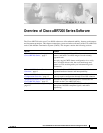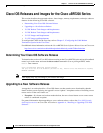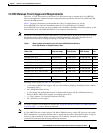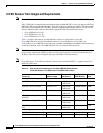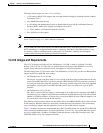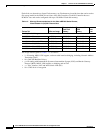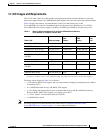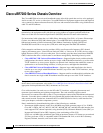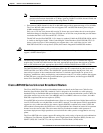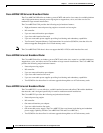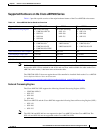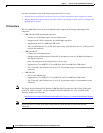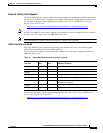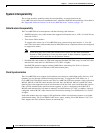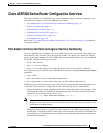
1-8
Cisco uBR7200 Series Universal Broadband Router Software Configuration Guide
OL-2239-05
Chapter1 Overview of Cisco uBR7200 Series Software
Cisco uBR7200 Series Chassis Overview
Cisco uBR7200 Series Chassis Overview
The Cisco uBR7200 series universal broadband routers allow high-speed data services to be packaged
similar to cable TV service or video fare. Cisco uBR7200 Series equipment supports data and digitized
voice connectivity between Internet Protocol (IP) hosts and connected subscribers using a bidirectional
cable TV and IP backbone.
Note For 6 MHz National Television Systems Committee (NTSC) cable plants not fully upgraded to two-way
transmission, the equipment works with dial-up access products to support upstream traffic from
Data-over-Cable Service Interface Specification (DOCSIS)-based telco-return cableinterfaces.
For international cable plants that use 8-MHz Phase Alternating Line (PAL) or Systeme Electronique
Couleur Avec Memoire (SECAM) channel plans, Cisco uBR7200 Series equipment supports
bidirectional transfer of traffic between the CableModem Termination System (CMTS) and
EuroDOCSIS-based CMs or set top box (STB) units with integrated EuroDOCSIS modems.
Cable companies and Internet service providers (ISPs) can allocate radio frequency (RF) channel
capacity for Internet access, Virtual Private Network (VPN), or Voice over IP (VoIP) services using a
hybrid fiber/coax (HFC) or all-coax cableplant. Cisco currently provides three router-based DOCSIS
CMTS solutions that offer a wider feature set and better manageability than bridge-based systems.
• Cisco uBR7246 VXR Universal Broadband Router—Supports higher density and broad media
configurations; the chassis contains up to two single-width IP backbone interfaces, up to four cable
TV RF interfaces, up to two power supplies, an optional clock interface that enables the router to
synchronize to an external timing reference, a faster processor, and higher bus bandwidth.
• Cisco uBR7246 Universal Broadband Router—Supports large cable installations; the chassis
contains up to two single-width IP backbone interfaces, up to four cable TV RF interfaces, and up
to two power supplies.
• Cisco uBR7223 Universal Broadband Router—Supports small-to-medium cable installations; the
chassis contains one single-width IP backbone interface and up to two cable TV RF interfaces.
Note This guide focuses on Cisco uBR7200 Series software. For detailed descriptions of CiscouBR7200
Series chassis and components, refer to the Cisco uBR7200 Series Hardware Installation Guide and
appropriate field replaceable unit (FRU) documents on Cisco.com.
Cisco cable interface line cards serve as the RF cable TV interfaces, supporting downstream and
upstream signal combining and splitting arrangements. The cards currently require external
upconverters to connect to the cable system. Cisco port adapters connect to the IP backbone and external
networks. Your cable plant, combined with your planned and installed subscriber base, service offering,
and external network connections, determine the Cisco uBR7200 Series chassis, cable interface line
cards, port adapters, and other components you use.
Data is modulated or demodulated using either of the following two methods:
• Downstream 6MHz channels in the 54-to-860 MHz range with upstream ranges of 5 to 42MHz.
Cisco MC11 FPGA, MC11C, MC12C, MC14C, MC16B, MC16C, and MC16S cable interface line
cards support NTSC channel operation, using standard (STD), Harmonic Related Carrier (HRC), or
Incremental Related Carrier (IRC) frequency plans conforming to EIA-S542.
NTSC uses a 6 MHz-wide modulated signal with an interlaced format of 25 frames per second and
525 lines per frame. NTSC is compatible with CCIR Standard M.PAL, used in West Germany,
England, Holland, Australia, and several other countries.




